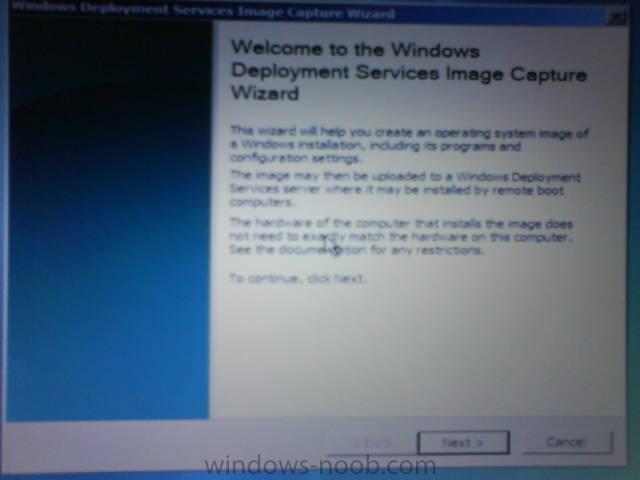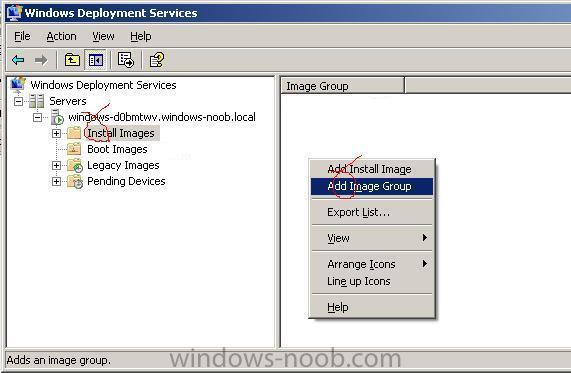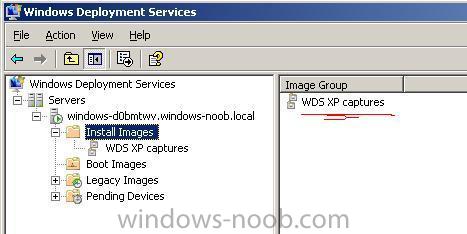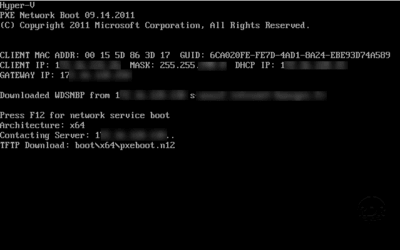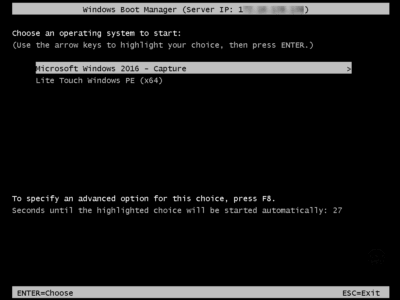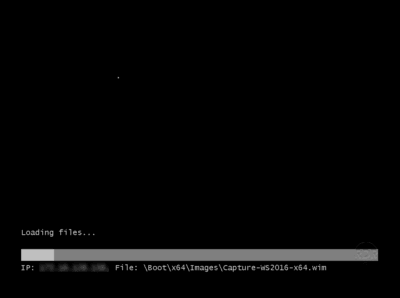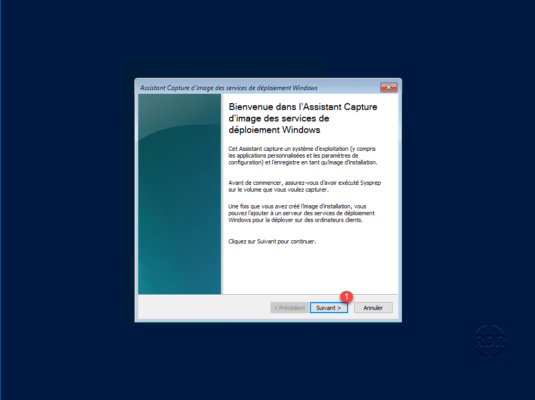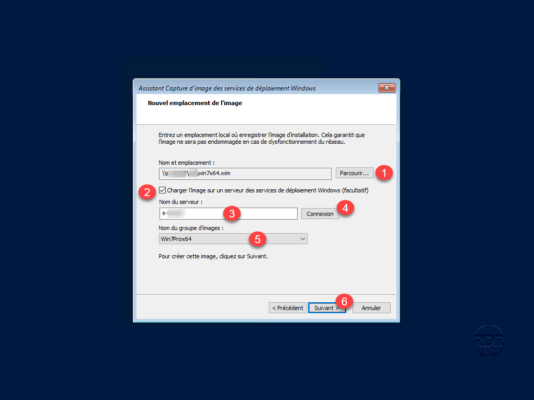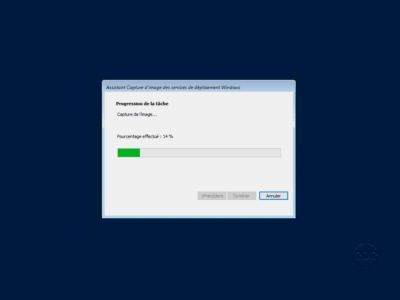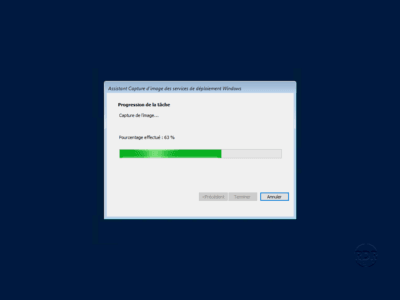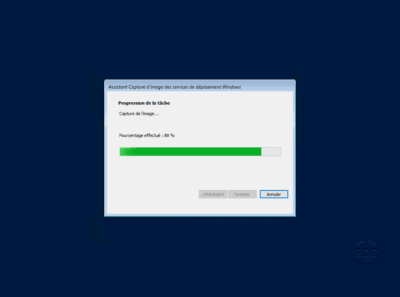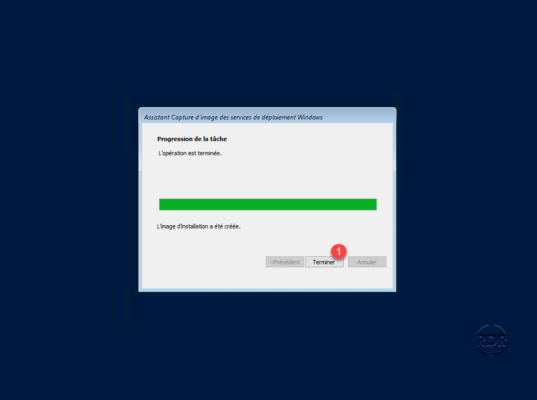Source
The text of following chapter is an adapted* extract of «Mastering Windows 7 deployment», by Aidan Finn,Darril Gibson,Kenneth van Surksum, published by Sybex.
How to Create a Capture Image by Using WDS Console
«The boot image that» I have «talked about will be used to deploy installation images on computers.
You can choose to use the default installation image from the Windows 7 media, but it is likely that you will want to add extra software, such as Microsoft Office 2010» (or the agent of the antivirus software that you are using in your network) »
or customize the image configuration in some way that is not possible with an unattended answer file. If so, you will need to create a custom image. WDS will allow you to boot up a generalized template machine with a
capture image (these images provide an alternative to the command-line utility,
ImageX.exe). A capture image is a specialized boot image that is used to create a new installation image file and store it in the image store of the WDS server.»
Note —> You can create media (a CD, DVD, or USB drive) that contain a capture image, and then boot a computer from that media.
«A capture image is created from an existing boot image. You will create a new capture image by right-clicking on an existing boot image and then selecting
Create Capture Image option (see the following figure). The
Create Capture Image Wizard will start.»
«The default details in the Image Name and Image Description fields will be derived from those same details in the source boot image. You should customize them to make it clear that this is a capture image
rather than a normal boot image.
The
Location And File Name filed is used to specify where the new WIM file for the capture image will be created. I am going to show you a little shortcut. The wizard will lead you to think that you should create the new WIM file in a temporary location
and then add it again in a later step. I feel like that is a bit of wasted effort. Instead, I recommend that you simply create the new capture image file in the image store location for boot images. That will eliminate the additional step. You should create
32-bit images in RemoteinstallBootx86Images and
64-bit images in RemoteinstallBootx64Images. «
Look at the following figure:
«The source boot image will be used as a template for the new capture image file. The new capture image WIM file will be added in the location that you have specified.
The screen in the following figure will appear when the image creation has completed successfully. Clear the
Add Image To The Windows Deployment Server Now check box if you have followed my advice on where to create the image. This option is used when you have created the capture image in another location and want to add it to the correct location.»
Returning to the WDS console, you can right-click on you server and select
Refresh. Browse into Boot Images and you should see your new capture image. This is a new WIM file that is independent of the source boot image and consumes disk space. You will need to remember to update this capture image
with any new driver packages that you add from this point on. Remember that you may also need to have 32-bit and 64-bit capture images.
You will now use this capture image to boot up the reference machine and capture the generalized image.
Known Issues when Creating Custom Install Images
When you boot into the capture image, the
Image Capture Wizard will start. Note the following notes about this wizard:
- You will only see drives that contain operating systems prepared with
sysprep. If you do not run sysprep on the computer before you boot into the image, you will not see any drives to capture.
- You must enter a local location to save the new install image; otherwise, you will not be able to capture the image. This location can be a mapped network drive but Microsoft recommends that you use a local location to avoid image
corruption in the event of a network malfunction.
How to Create An Image by Using a Capture Image
Power up the reference machine and boot it up on the network. Choose the capture boot image when the PXE client starts.
The boot image will download over the network and start. You can skip the welcome screen to get to the
Directory To Capture screen, as shown in the following figures:
You have to enter three pieces of information. You should select the volume letter that you want to capture using WDS. This highlights a limitation of WDS; you can only capture and deploy a single volume. You might notice something
odd here. The volume we are capturing is shown as D:, even though it is the C: drive when the reference machine is booted up. There is a handy solution you can use if you are a little confused about the volume that you are capturing.
- Start command prompt in Windows PE by pressing Shift+F10.
- Navigate the volumes (cd) and list their contents to see which volume letter it is that you need to select. You can so this using
diskpart and by running the list volume command.
Enter the image name and description as you want them appear in the WDS console and to users when they are deploying images to their machines. You can change the name and description later in the console.
The New Image Location screen is where you configure the location of the new image that is to be created and if and how you want the image to be uploaded to the WDS server.
Click Browse to select a location to create the new installation image in and to name the file. You can create the new image on the same volume that you are capturing if there is sufficient space. You will need an additional local (not network-based)
volume if there is not enough space.
Optionally select the option to upload the new image to the WDS server. If you do want to do this, click the
Connect button to authenticate with the WDS server. Once you have entered valid credentials, you can select an
Image Group to add the new image to. This will use Single Instance Storage (SIS) to reduce the amount of disk space that is needed to store the image. Make sure you choose an image group that matches the operating system, edition,
and architecture of your new image.
The image is captured and will be uploaded to your WDS server if configured. The image will then be available for further configuration (such as access permissions) and deployment to other machines. Look at the following figures:
Note —> Remember that you will need to refresh the WDS console (if it was open already) to see the new installation image.
Загрузить PDF
Загрузить PDF
Windows Deployment Services (WDS) представляет собой серверное программное обеспечение для обработки изображений, разработанное Microsoft. Windows Deployment Services (WDS) (Службы развертывания Windows) используются для развертывания установки Windows, как Windows 7, по сети. Учрежденные в Server 2008 и более поздних версиях как дополнительная установка в Server 2003 SP2, файлы образов Windows Deployment Services находятся в Windows Imaging Format (WIM). В этой статье мы покажем вам, как установить установочный образ и захватить изображение для развертывания по сети.
Шаги
-
1
Установите Windows Deployment Services (WDS) Role. В Server manager щелкните правой кнопкой мыши Roles и выберите Add role. Мастер Add role должен появиться на экране приветствия, нажмите кнопку Next. Выберите Windows Deployment Services Role в в нижней части списка и нажмите кнопку Next. Примите значения по умолчанию и нажмите кнопку Next. Нажмите кнопку Install.
-
2
Настройте Windows Deployment Services Server. После установки перейдите в меню Start => Administrative tools => нажмите Windows Deployment Services.Щелкните правой кнопкой мыши по Srvers, выберите Add server. Выберите Local computer и нажмите кнопку OK. Щелкните правой кнопкой мыши по Server и нажмите кнопку Configure server. В экране приветствия нажмите кнопку Next. На этой странице вам нужно выбрать место для хранения изображений, нажмите кнопку Next. Поскольку сервер запускает DHCP, выберите «Do not listen to port 67» и «Configure DHCP option to 60 to PXE Client», нажмите Next. Выберите, как вы хотите, чтобы сервер отвечал клиентам. Если вы выбираете «respond only to known client computers», вам необходимо будет ввести компьютеры вручную. нажмите Next, а затем нажмите Finished.
-
3
Добавьте Boot Image (образ загрузки). При нажатии Finished после настройки сервера должно появиться окно Add image wizard (Мастер добавления изображения). Если нет в окне Windows Deployment Services, щелкните знак плюс рядом с серверами и щелкните знак плюс рядом с вашим сервером, который вы добавили. Щелкните правой кнопкой мыши на Add Install Images. Выберите Create a new Image Group и переименуйте группу образов. Нажмите Browse чтобы выбрать изображение Windows (.WIM-файл), который хотите использовать и нажмите кнопку Next. Если есть больше чем одно изображение в файле .WIM, на следующей странице вам нужно выбрать нужные вам изображения и нажать кнопку Next. Убедитесь, что все правильно на сводной странице и нажмите кнопку Next. Изображение или изображения будут установлены. Когда установка будет завершена, нажмите Finished.
-
4
Создайте Capture Image. Щелкните правой кнопкой мыши папку загрузочного образа под вашим сервером в окне Windows Deployment Services и выберите Add boot image. Найдите нужный вам загрузочный образ (boot.WIM) файл и нажмите кнопку Next. Дайте загрузочному образу имя и описание, нажмите кнопку Next. Подтвердите и нажмите кнопку Next. После установки нажмите Finished. Щелкните правой кнопкой мыши образ загрузки и выберите пункт «Create a Capture Boot Image», нажмите Next. назовите и дайте описание Image Capture, выберите загрузочный образ, который вы установили, и нажмите кнопку Next. Когда изображение захвачено, нажмите Finished.
-
5
Запустите Sysprep на клиентских ПК (Client PCs). Загрузите клиента. Нажмите кнопку Start => Computer => local drive C:. Путь к файлу -C:Windowssystem32Sysprep. Откройте Sysprep и запустите приложение Sysprep. Установите систему clean up action (очистки действия), чтобы ввести систему Out-of-Box Experience (oobe). Мы рекомендуем вам установить опцию Shutdown option в shutdown, включите флажок возле поля Generalize box и нажмите кнопку OK. Sysprep запустит процесс удаления уникальных идентификаторов безопасности IDs и другой уникальной информации.
-
6
Загрузите сеть. Загрузите компьютер, введите комбинацию клавиш для входа в меню загрузки перед загрузкой Windows. Комбинация отобразится на экране, когда Bios загружается, как правило f12. Если вам нужно снова увидеть комбинацию или пропустить время, чтобы ввести команду, нажмите комбинацию клавиш Ctrl+Alt+Del для перезагрузки. При загрузке в меню загрузки выберите Boot into network. Выберите Capture image из диспетчера загрузки Windows (Boot Manager), чтобы загрузить Windows Deployment Services Image capture Wizard.
-
7
Завершите работу мастера Windows Deployment Wizard. Начните с выбора громкости, чтобы захватить. Если вы ищете диск C:, iн был изменен из-за Sysprep, потому C: содержит файлы загрузки. После выбора громкости, чтобы захватить, назовите образ и дайте ему описание, нажмите кнопку Next. Установите Upload image to Windows Deployment services server. Вам будет предложено ввести полномочия. Затем выберите название изображения из выпадающего списка. Теперь нужно установить диск, удерживая клавиши Shift+F10, чтобы войти в Command Prompt. В Сommand Prompt введите: net use *\ServernameFolder. Пример: net use *\Houndmy images. То что в скобках «*» выбранная буква диска не используется, «Hound» — имя вашего сервера и»my images» — папка для сохранения образа. После ввода команды нажмите Enter. Выйдите из Сommand prompt. Выберите чтобы найти расположение, созданное в командной строке. Нажмите Next. Теперь жесткий диск cкопирован на сервер. Вы захватили изображение.
Реклама
Что вам понадобится
- DHCP-сервер, работающий на домене
- DNS-сервер, работающий на домене
- Компьютер, который является членом Active Directory Domain Service
- NTFS NTFS раздел на сервере Windows Deployment для хранения образов.
- WIM Image из инсталляционного диска ОС Windows( Windows Installation Disk)
Об этой статье
Эту страницу просматривали 9836 раз.
Была ли эта статья полезной?
Windows Deployment Services (WDS) is used to capture image and deploy operating system(OS) images also know as WDS images remotely to other computers over a network. In earlier post we have learned the steps to install WDS Server 2012 and install OS using WDS Server 2012 R2. In this post we’ll capture image of OS by using Windows Deployment services image Capture wizard and then we would deploy it to other computers and servers in the environment.
Capture Image is required for an environment where you have to deploy similar Operating System and some common applications on multiple computers. It save lots of administrative efforts required for large deployment.
Before we start with the steps of capture image, install an OS on the Server and then install all the applications that are common for your environment also know as base applications for the Production environment.
In addition to that, ensure that DHCP Server is working in your environment. Change the booting sequence to “Boot from Network” and then follow the steps given below.
Steps to Capture Image using WDS (WDS Images)
1. Open Windows Deployment Services (WDS) console, expand Server name and select “Boot Images”. Right click on the boot image, select Create Capture Image to create the capture image. This capture image will help to boot the computer to capture computer’s OS for further deployment of Operating System to other computers either client or server.
2. On “Create Capture Image Wizard“, enter the name and description of the image. Click on browse to specify the location where this would can be saved. Click on Next, this will create the capture image and saves it to the location that we have specified.
3. On “Create Capture Image Wizard”, when the image is successfully created check on the “Add image to the Windows Deployment Server now” to add this captured boot image to the WDS server now, you can also add this image later from the WDS console. Click on finish to upload the OS file and close the console.
4. We can verify if Capture image is uploaded to WDS Server or not by selecting “Boot Images”.
5. Before we start with the steps of capture image using Windows Deployment Services, make some changes on the server. In this practical, we have created some folders in the C: drive and installed the role of Remote Desktop Services. In addition to that, you can install few additional software or make any other changes as per your organization’s requirement.
How to install Domain Controller
6. Open Run, type sysprep and click on OK. It is a system preparation tool and its default path is “C:WindowsSystem32sysprep”. It is used to define new computer name and unique SID to the newly build computer.
7. Double click on Sysprep. Sysprep will prepare our computer for the capturing.
8. On System Preparation Tool console, we can see the importance of sysprep. It will prepare the machine for hardware independence and cleanup. Check on Generalize and select “Shutdown” from the drop down menu of Shutdown Options. Click on OK. Sysprep will start working and then shutdown the computer.
9. Change the boot sequence to “Boot from Network” before powering on the Server. Power on your computer and press F12 to make your computer boot from network.
10. On “Windows Boot Manager” select the capture image and hit enter.
11. On “Windows Deployment Services Image Capture Wizard“, details about WDS and all the pre-requisites are mentioned. Click on Next to continue.
12. On the “Windows Deployment Services Image Capture Wizard” console, select the directory or volume to capture. Don’t get confused if you don’t see C: here and only see D: as C: would be used for booting and D: is the original drive that has all the information. Here, we have selected D: drive to capture an OS. Enter name and description and then click on Next to continue.
13. On the location console, click on browse to enter the location where this file would be saved locally. Check on “Upload image to a Windows Deployment Services Server” to directly upload this file to the WDS server. Enter the name of WDS server in Server Name field and click on connect.
How to promote Additional Domain Controller
14. A “Windows Security” console would ask for domain administrator credentials. Enter credentials and click on OK.
15. Select the group menu from drop down menu and click on Next to start capturing.
16. After the completion of capturing install image click on Finish to close the wizard.
17. On WDS Server, expand server name (how to rename Windows Server), expand Install option, expand group and verify if the captured Operating System is uploaded to the WDS console or not.
How to Deploy Captured Image using WDS
Before we start with the steps of deploying captured image, ensure that DHCP server is working in your environment and client is enable for boot from network.
18. On the client computer, press F2 and go to the BIOS option and change the boot option to “Network”.
19. When the client received IP address from DHCP (configure DHCP Server) it will be ready to boot from network. In this example client received an IP address that is 192.168.1.112. Press F12 for network boot.
20. Select the boot image and not the Capture Image to boot the computer from network. Client machine loads the boot.wim file from the WDS server.
21. It starts booting the client from the boot file on WDS server. The IP address of WDS server is 192.168.1.11 and path of boot image on WDS server is “Bootx64Imagesboot.wim”.
22. On Windows Setup console select location and keyboard or input setting and click on Next.
23. Enter the domain credentials to make this client install OS through WDS (Winodws Deployment Services).
24. On Select Operating System console, list of all the Operating Systems are listed which were added in the WDS server. Select “Install_Capture_Image” to install the captured Operating System on the client computer. Click on next to continue.
25. After the completion of Operating System installation, verify that the folders that we created and the roles that we installed exist on the client computer. It confirm that the OS that we captured is successfully installed on the client computer.
26. Similarly you can deploy the captured Operating System on all the client machines. It can be used for deploying Windows 7 image over network along with other WDS images e.g. Server 2012, Windows Server 2008, Windows 7, Windows 10, etc. Windows Deployment services for Windows 10 is a great tool used by System and IT Administrators to capture and to deploy OS images in most of the Organizations.
Create and capture Windows 10 reference image is important because that image serves as the foundation for the devices in your organization. In this topic, you will learn how to capture Windows 10 reference image using WDS.
This image is the core operating system you need on your network environment. The image require all needed software for your Windows 10 clients to be installed. So before capturing Windows 10 image, make sure you update Apps and Windows with latest updates.
Capture a Windows 10 image with Windows Deployment Services is easy if you would be familiar with Windows Deployment. Before applying this article, you need to have installed WDS on Windows Server. If you lab is ready for deploying Windows follow the article, otherwise read and apply the below articles to create your Deployment Server first.
- How to Install and Configure WDS In Windows Server 2012 R2?
- Configure Windows Deployment Services on Server 2012 R2
- Deploying Windows 10 Using WDS Server 2012 R2
- Customizing Windows Image Using DISM for Windows Deployment
So let’s begin to capture Windows 10 reference image.
1. Press Windows+R to open run and type Sysprep and run Sysprep. On the Sysprep tool select Enter System Out-of-Box Experience (OOBE) and select Generalize the click OK.
2. Once the Sysprep has complete, system will restart and boot it from Network. You must configure you system to boot from network. Just press F12 to go to Pexe.
3. Now select Capture Image to capture Windows 10 reference image or PC.
4. On the Welcome to Windows Deployment Services Image Capture Wizard page click Next.
5. Now select the directory where you want to capture, type image name and image description then click Next.
6. Select Name and Location or tick the check box of Upload image to a Windows Deployment Services server. When done click Connect and type user credential. Select Image Group name also then click Next.
7. This will take a long time to complete the process of capturing Windows reference PC.
8. When it has complete click Finish and restart your Windows 10 reference PC. Configure and select the reference PC language, time, user and password, because it has been completely out of box by executing Sysprep.
9. Go to Windows Deployment server and check the result of Windows 10 capturing. The Windows 10 captured image should be transferred successfully to WDS server.
OK, that’s all about to capture Windows 10 reference image with WDS and Windows Server 2016 or Server 2012 R2.
Capture Windows 10 Reference Image video tutorial
If you have any question let us know and how can we help you to solve your OS and App deployment problems in your production environment.
Part 3 — PXE boot target computer and capture image
Step 1. Ensure that PXE boot is enabled in boot sequence, and PXE boot (using your onboard NIC) to the WDS server. Press F12 when prompted for Network Service boot.
Step 2. In the Windows Boot Manager Menu, select Windows Vista/XP WDS Capture from the available options.
Step 3. After Windows PE has booted, you should see a welcome screen which says
Welcome to the Windows Deployment Services Image Capture Wizard.
Click next to begin.
If you do not see this welcome screen (for example if you see an Install Windows wizard with keyboard layout options) then power off the computer and re-attempt step 1.
Step 4. Image capture source:
There are three options here, Volume to capture, Image name, and image description.
Note:-If the Volume to Capture drop down menu appears blank (ie: you can’t select anything) then verify that you have Sysprepped the image you are trying to capture.
In addition, You must sysprep using the generalize switch (Vista ONLY). After sysprepping with the /generalize switch it will show up.
For XP, simply regenerate the SID and choose RESEAL.
If you need to sysprep the machine then read this guide and return to part 3 when ready.
If volume to capture still doesnt show up after sysprepping with the /generalize switch then perhaps WinPE may need storage drivers (SATA). To verify this, once you’re in WinPE, press Shift+F10 and see if you can see the hard drive.
For Volume to Capture, select C: from the drop down menu (will not be present unless you have SYSPREPPED)
For Image Name call it ‘Windows Vista Ultimate Capture’ (if you are capturing Windows XP, change accordingly)
For Image Description, enter ‘WDS — Windows (vista/xp) captured image for windows-noob.com’
Step 5. Image Capture Destination:
Here you have the possibility of storing the image on a drive (local) by choosing Name and Location, and clicking Browse and giving the image a filename, the wizard will auto-append .wim to the file name eg: c:test_capture.wim.
Next you want to upload the image directly to your WDS server by putting a check mark in the ‘Upload Image to WDS server‘ option, you will have to provide the servername (or use the ip address eg: 192.168.3.1) and then click on the connect button. After some moments you’ll be prompted with a username/password prompt for connecting to the server. I entered Administrator as the user and entered the correct password and selected ‘remember my password’, followed by ‘ok’. If you do not get prompted for username/password and it complains about not finding the server then read here.
Once you have successfully connected to the server you may get an error which states:-
«There is no image group on the WDS server ‘192.168.3.1’. Please use WDS Management to create an image group.»
If you do not get this error, skip to Step 6.
To resolve this error simply go back into the WDS management gui, and select ‘Install Images‘ in the left pane. In the right pane that opens, right-click your mouse and choose ‘Add Image Group‘. Give this group the name ‘WDS XP captures‘ and retry the above step (5). Obviously if you are capturing Windows Vista, change the group name accordingly.
Once you’ve added the image group it will appear in the WDS gui like the below screenshot
Step 6. you will now see the ‘Image Group Name‘ option on the Windows Deployment Services Image Capture Wizard allows you to drop down the menu, and from here you can select the captured images group you created above.
Step 7. Click Finish to continue (and capture the image). The image capture wizard will start capturing the image and you’ll see a ‘Percent Complete: x%’ dialogue box.
Step 8. After a fairly long while of file copying, Click Close to conclude the image capture process, congratulations you’ve captured an image using WDS !
Please note, that at this point Windows PE will exit and the computer will reboot, if you don’t want it to boot into sysprep then you’ll have to be quick and turn it off at the bios screen.
If everything went well as above, the captured image will have been copied to D:RemoteInstallImagescaptured images (change the drive letter to match your RemoteInstall drive and obviously the last folder name will change if you use a different image group name), in addition it will be stored locally on the computer you captured the image on (c:test_capture.wim)
Here are the contents of my captured images folder:-
Directory of D:RemoteInstallImagescaptured images
11/14/2007 04:08 PM <DIR> .
11/14/2007 04:08 PM <DIR> ..
11/14/2007 04:15 PM 2,485,945,229 Res.RWM
11/14/2007 04:15 PM 2,297,798 test_capture.wim
2 File(s) 2,488,243,027 bytes
2 Dir(s) 11,278,798,848 bytes free
At this point you will probably want to Deploy the captured image, to find out how you can do that read this post.
Introduction:
In this post, we will learn the steps to Sysprep and Capture a Windows 10 Reference Image for WDS Server. Later you can use this captured image to deploy Windows 10 on multiple computers in your organization using WDS.
Windows Deployment Services (WDS) enables you to deploy Windows operating systems over the network, which means that you do not have to install each operating system directly from a CD or DVD.
A reference image is helpful when you want to deploy a similar OS with commonly needed software. It will save lots of administrative efforts and time required for large deployment.
So before capturing Windows 10 reference image, make sure you install all required software and update Windows with the latest updates.
Test Lab Setup:
Note: For this guide, we will use the virtual test lab created in VirtualBox.
- WS2K19-DC01: WDS Server (DC and DNS with DHCP)
- WDS-DEMO: Windows 10 machine (Updated)
Already I have installed commonly required applications like Adobe Reader, Google Chrome and WinRAR, etc. Install the software as per your requirements.
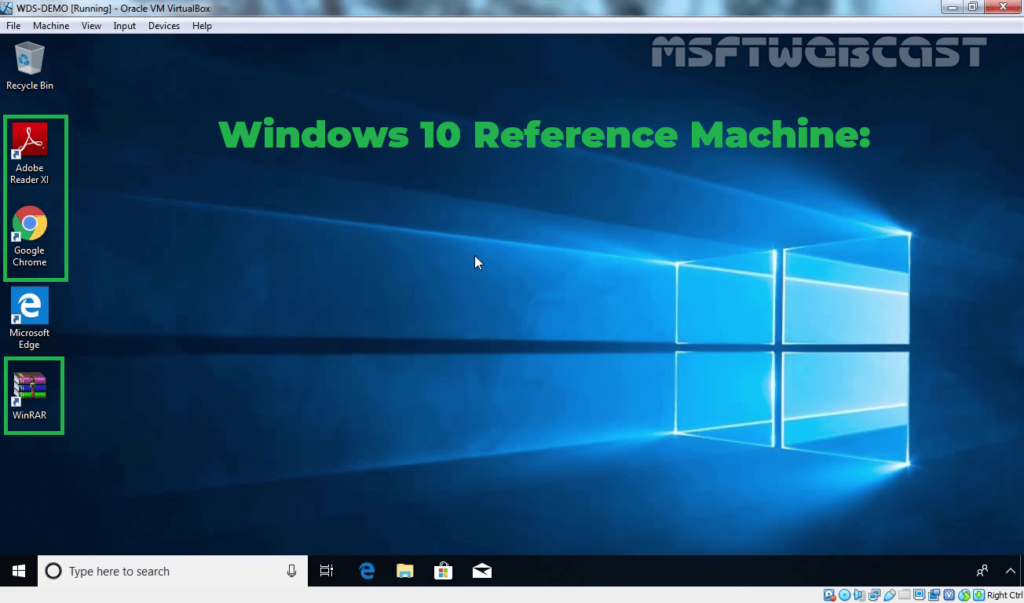
Follow this guide: Install and Configure WDS on Windows Server 2019.
Steps to Create a Capture Image using the WDS console:
1. On WDS Server, open Server Manager Console.
2. Click on Tools and select Windows Deployment Services.
3. Expand the Server name. Expand and click on Boot Images.
4. Right-click on the existing boot image and select Create Capture Image.
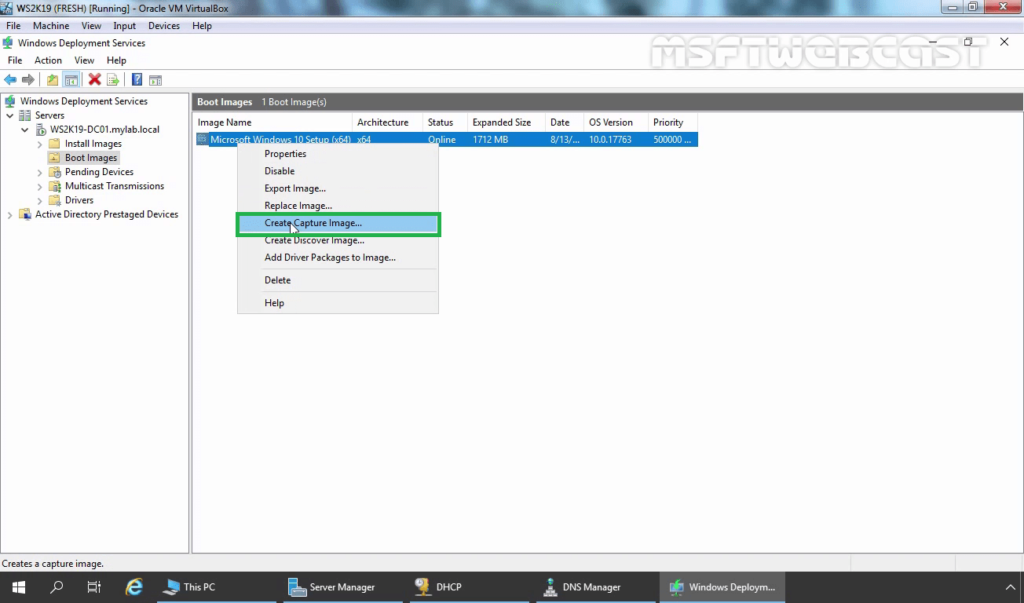
5. Specify the name and description of the image. Click on browse to specify the location to save the reference image. Click on Next.
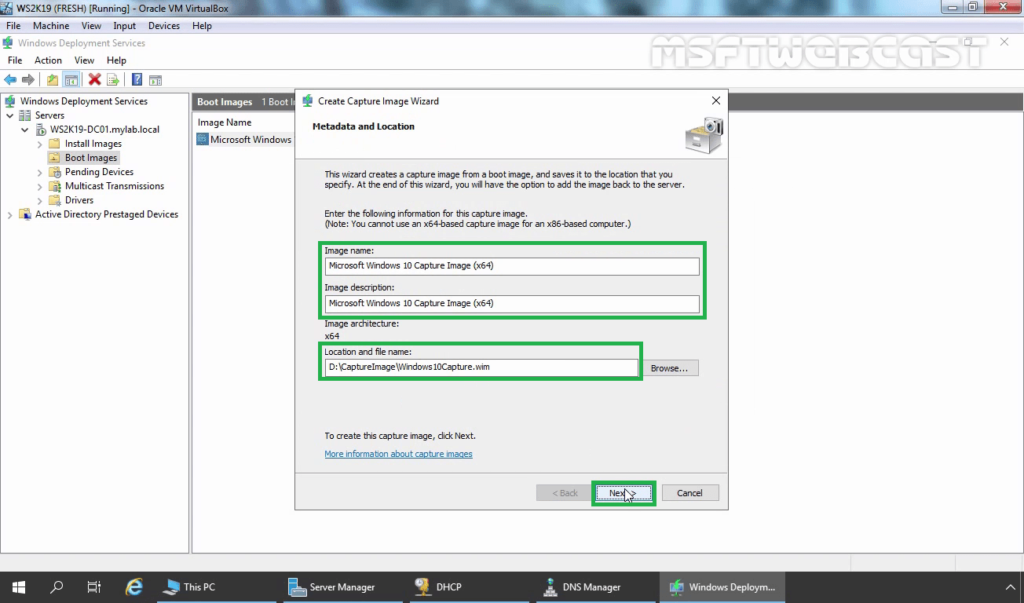
6. The Wizard will begin to capture a Windows 10 reference image.
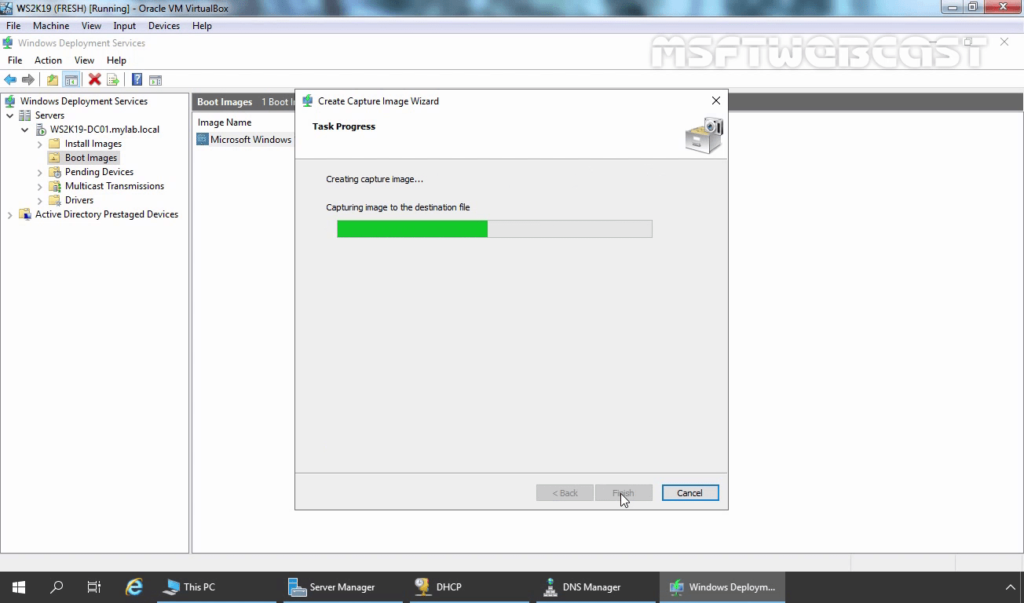
7. Select the Add image checkbox to add a captured image to the WDS server. Click Finish.

8. The Image file location is pre-filled out. Click Next.

9. Click Next.
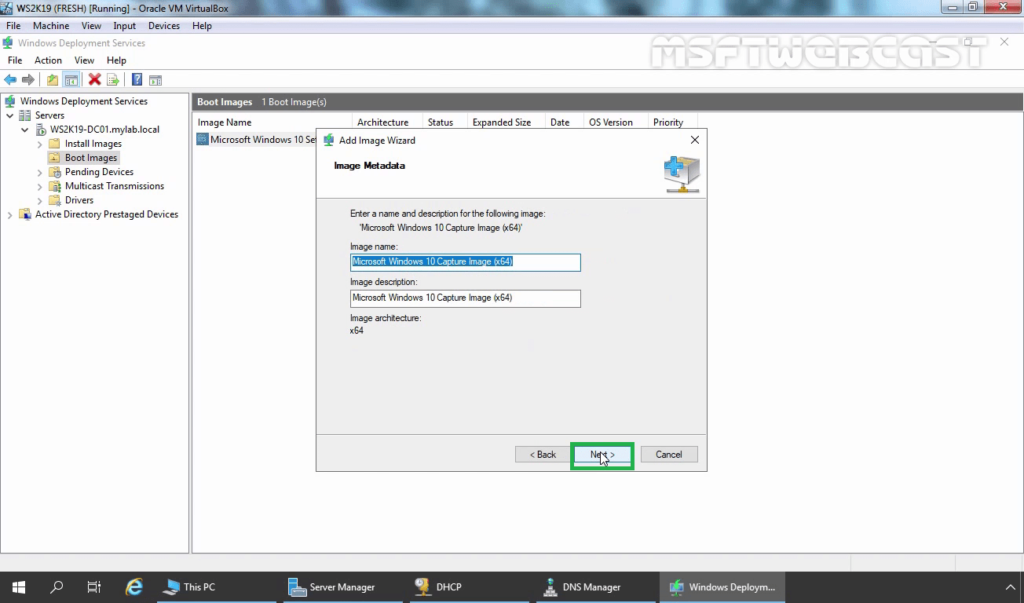
10. View the summary and click Next.
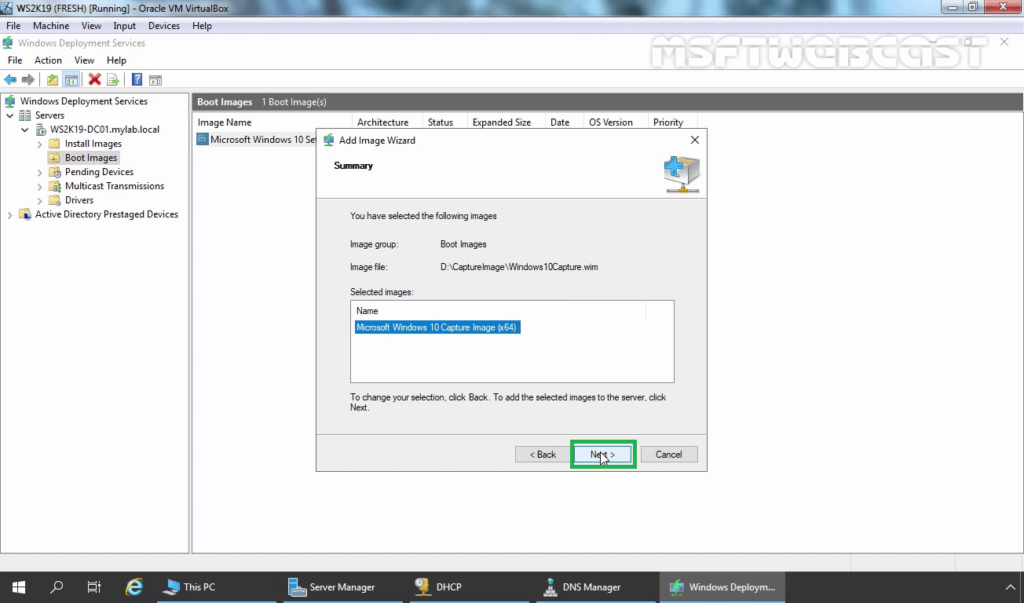
11. Wait for the process to finish. Click on Finish.

12. Verify the Capture Image under the Boot Images list.
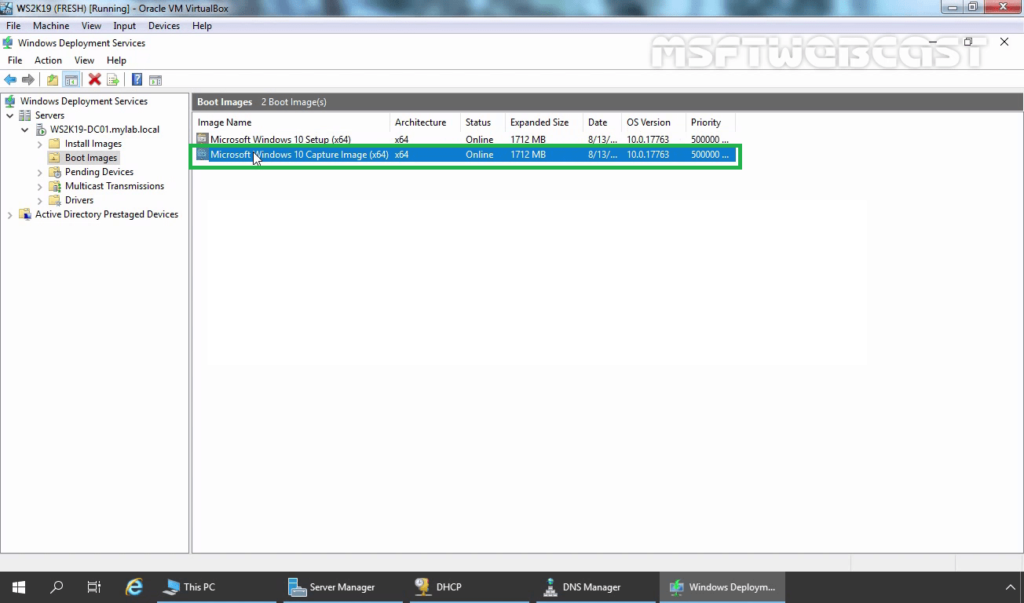
Sysprep Windows 10 to capture a Reference Image:
Every Windows OS has uniquely generated and assigned security identifiers (SIDs). If there’s more than one computer with the same SID on the network, then this could cause problems.
Sysprep tool is used to remove computer-specific information such as installed drivers and the SID from the OS. After that, we can use it to capture the reference image.
We have performed a clean installation of Windows 10. We have also installed some third-party applications on it.
13. On Windows 10, press the Windows key + R to open the run menu.
14. Type sysprep and then press enter key.
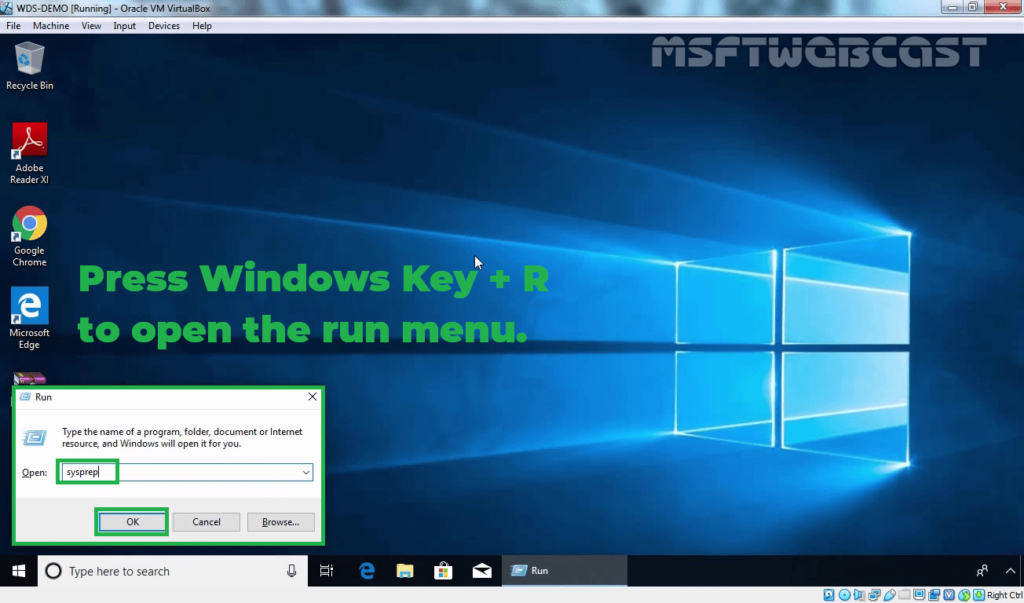
15. Double click on sysprep application.
16. Choose Enter System Out-of-Box Experience (OOBE) and select Generalize. Choose reboot and click OK.

17. Once the sysprep has complete, the system will restart.
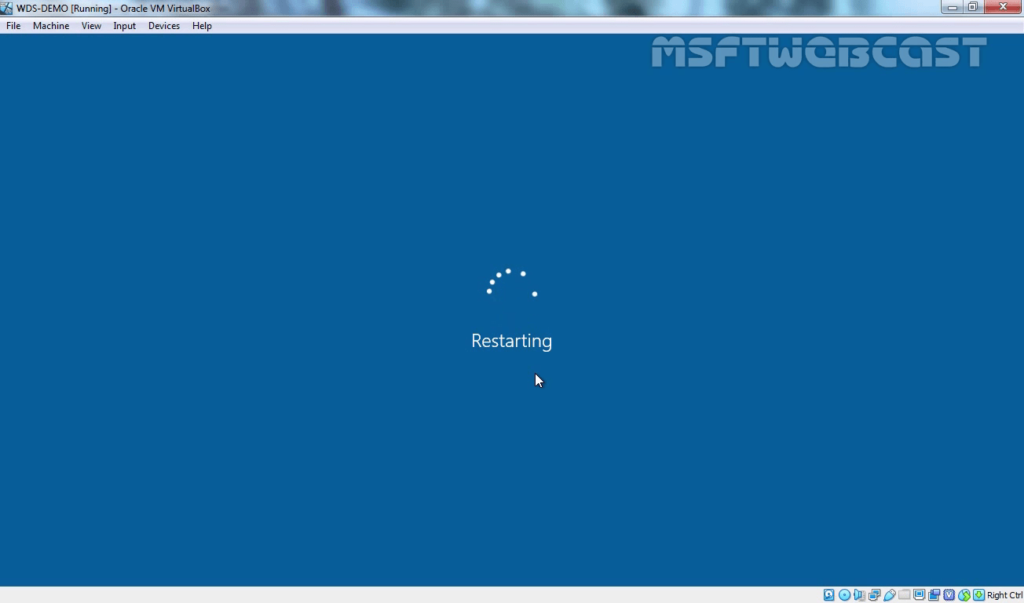
18. Configure your system to boot from the network, when prompted press F12 key to continue.
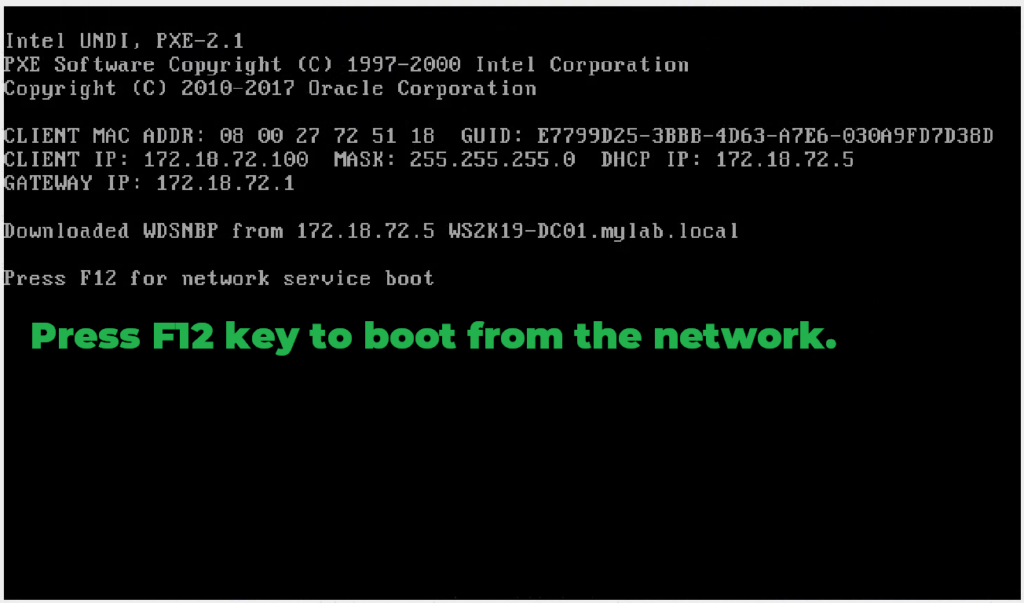
Capture Windows 10 Reference Image using WDS:
19. Now select Capture Image from the list to capture Windows 10 reference image. You can use arrow keys for navigation.
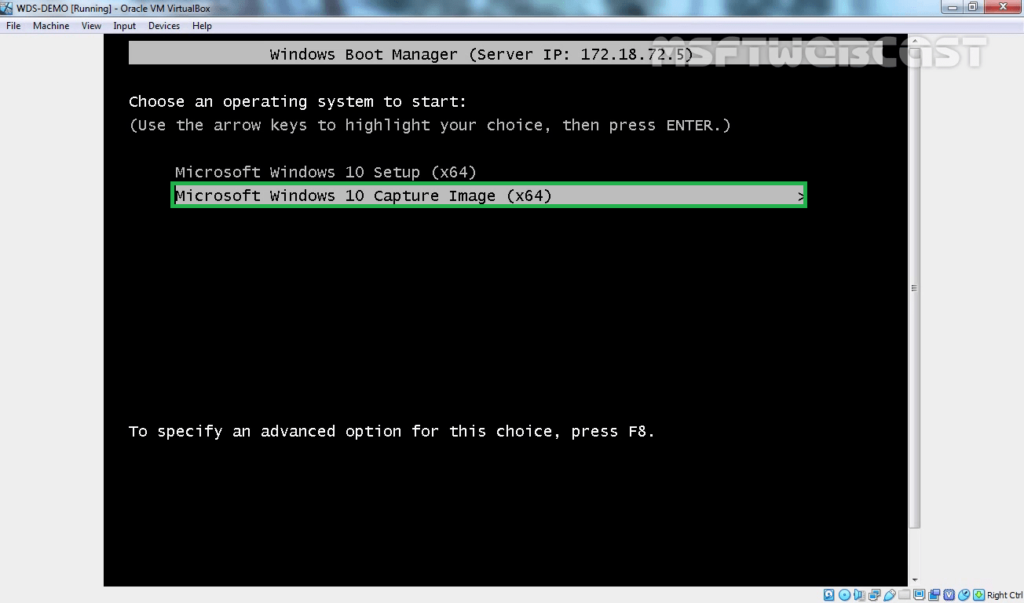
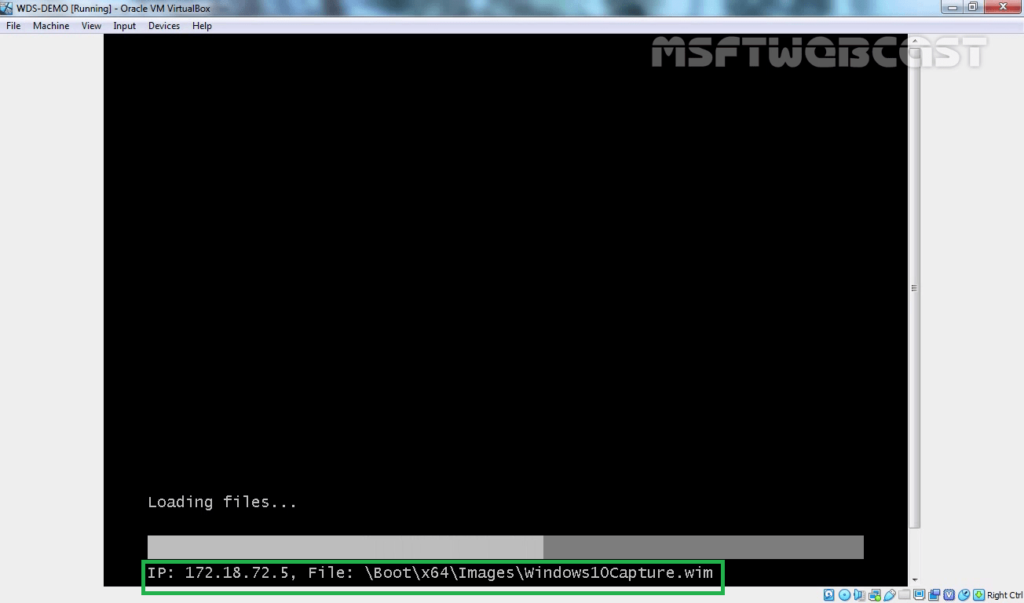
20. Click Next on the Welcome page.

21. Specify the volume to capture. Specify the image name and description then click Next.
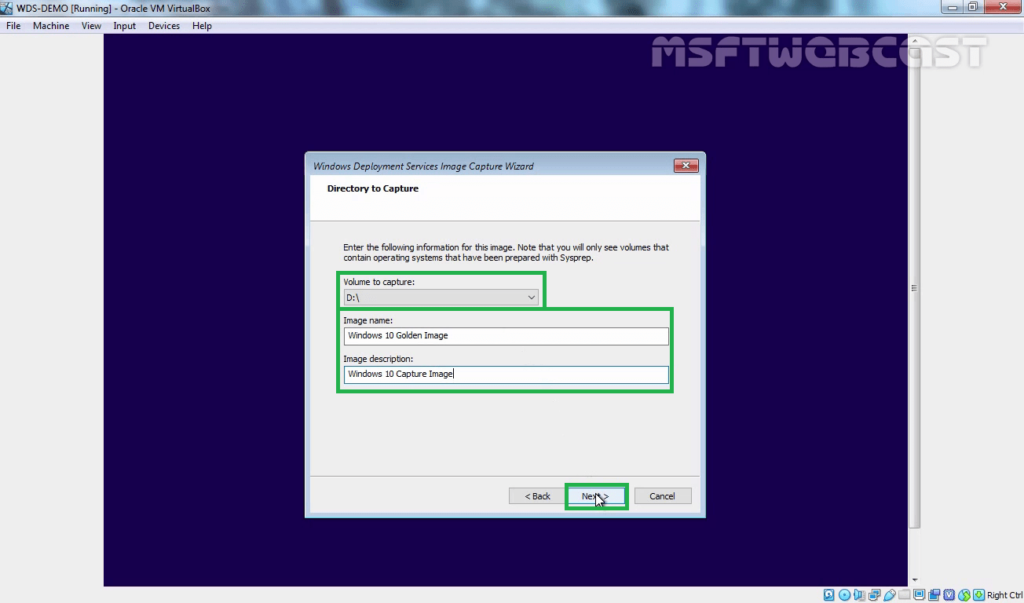
22. Click on browse to specify the location to save this reference image file locally.
Note: If you want to upload the image to the WDS server at the same time, then check on the “Upload image to a Windows Deployment Services Server”.
23. If you chose to upload the image to the WDS server, Enter the name of the WDS server in the Server Name field and click on connect.

24. Enter the credentials and click on OK.
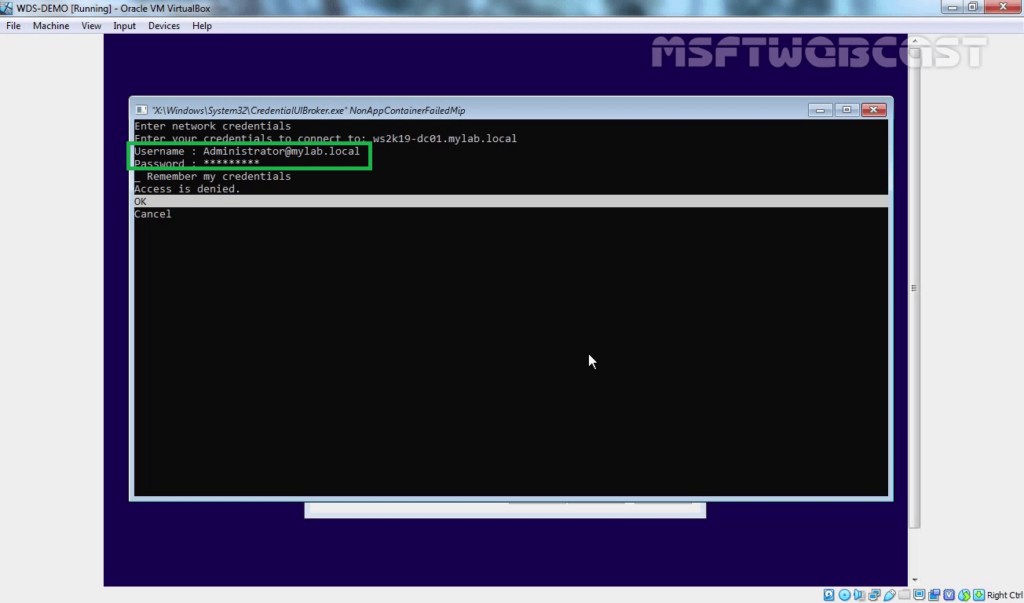
25. Select the group menu from the drop-down menu and click on Next to start capturing Windows 10 reference image.
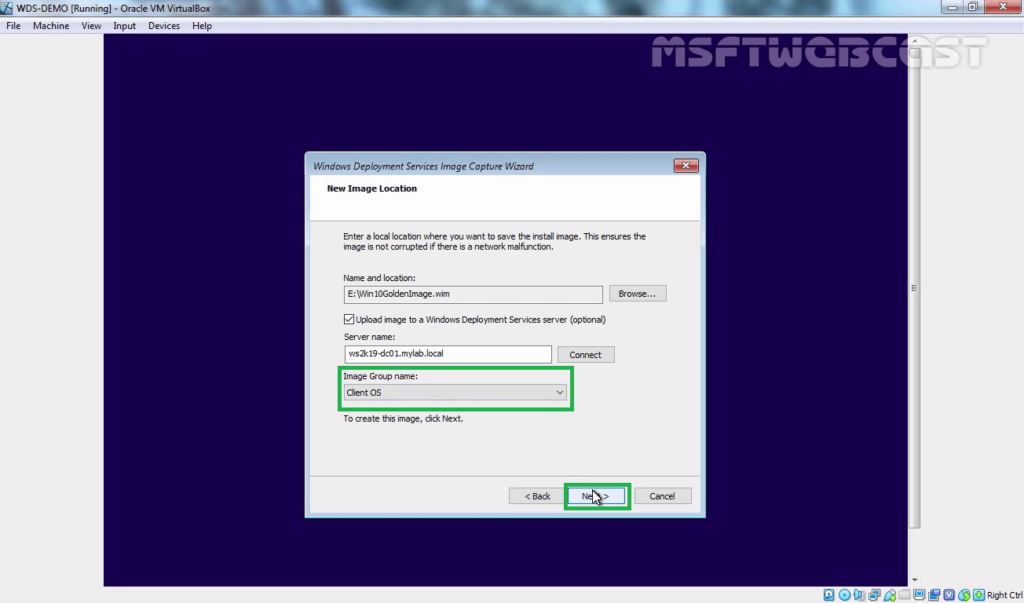
26. Click on Finish to close the wizard.
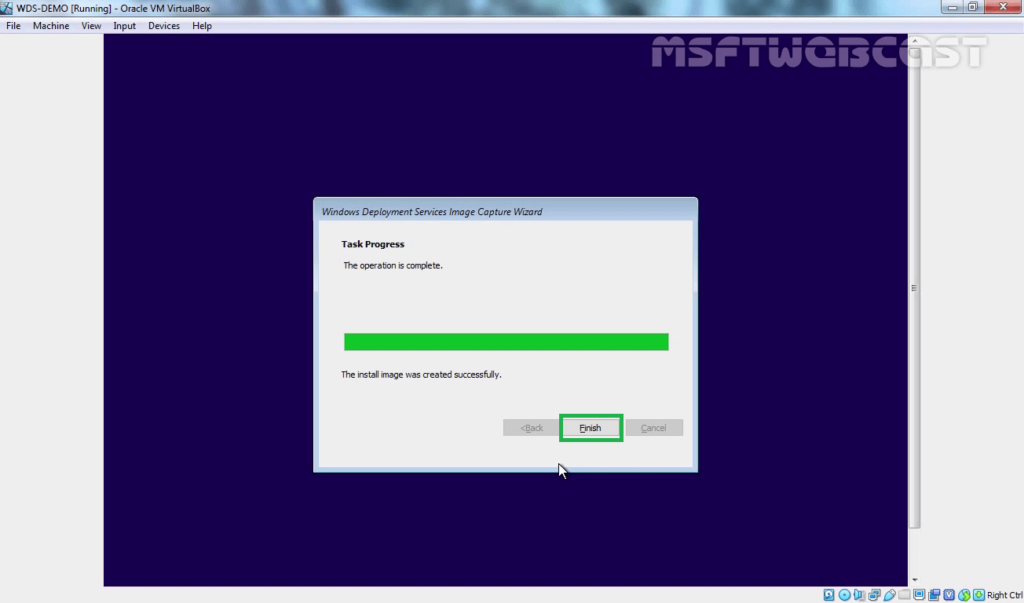
27. Go to the WDS server and check the result of Windows 10 capturing.
28. Expand Install Images, expand the image group, and verify the reference image is uploaded or not?
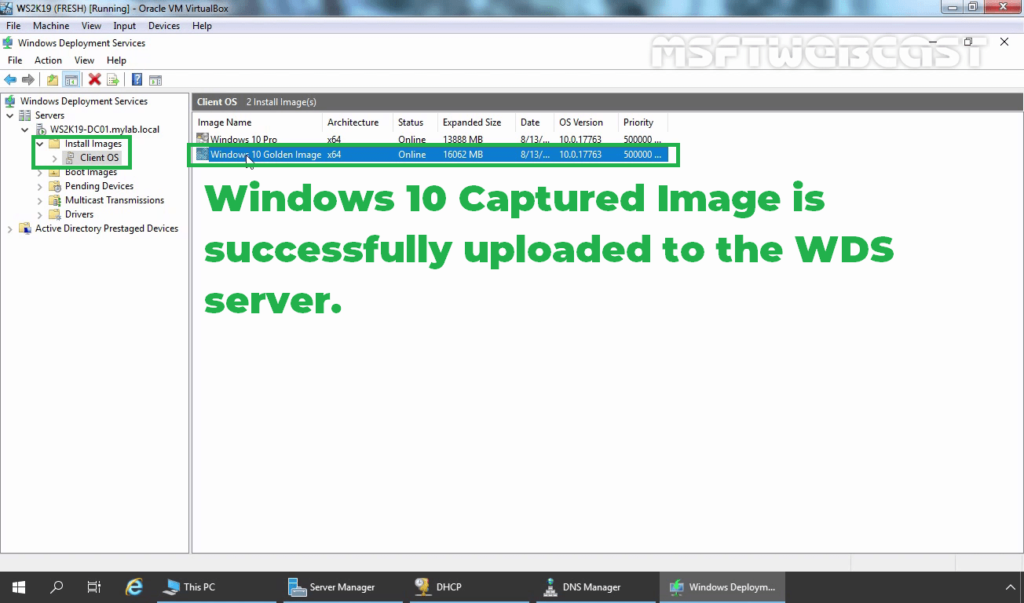
The Windows 10 reference image should be uploaded successfully to the WDS server.
That’s all for steps on how to Sysprep and capture a Windows 10 reference image using the WDS server 2019.
Thank you for reading this post.
Related Articles on WDS:
- How to Install WDS role in Windows Server 2019 Part-1
- How to Configure WDS server role on Windows Server 2019 Part-2
Post Views: 4,646
A capture Image is required for an environment where you are deploying similar Operating Systems that contain the same basic applications. The image is used to create a capture image. For the differences between Capture image, Discover image, Install and Boot images (Windows PE).
On how to add images to WDS and configure Multicast transmission via the GUI, see https://techdirectarchive.com/2020/05/26/windows-deployment-services-how-to-add-images-to-wds-via-the-gui-and-wdsutil/
Creating a capture image: Follow the steps below to have this done.
– Click on the boot image
– Right-click on the boot image on the right pane of the window and
– Select Create Capture Image as shown below.
Note: In this Window, you can do a lot of stuff as you can see below. Here we just want to create a Capture Image

Enter the image a name and a description as well.
– For location and file name, click on browse and browse to the path where the “RemoteInstall” folder is when we installed WDS role.
For more information on this, see ” How to configure Windows Deployment Services on Windows Server 2019“
This will ensure we have the Capture Image folder created under the RemoteInstall Directory
The Metadata and location will be like this as shown below
– Click on Next

This will continue the installation process and when done

– Click on Finish (Now the Capture Image has been created)

Now we have successfully created a capture image. Now we can see the captured file in the RemoteInstall location as shown below

Next, you will have to upload this image to WDS. This can be done by following the steps below.
– See how to add the Lite-Touch Images to WDS for a similar example.
Launch the WDS console and right-click on the Boot image
In the Add Image Wizard, browse to the image file as shown below
Click on Next to proceed when the image file has been selected.
In the Image Meta data window, click on Next
– You can add a descriptive name in your environment.
Review the summary as shown below and click on Next
When the image upload is completed, click on Finish as shown below.
As we can see on the WDS console, under the boot images, the Capture image we created has been uploaded successfully.
I hope you found this blog post helpful. If you have any questions, please let me know in the comment session.
INTRODUCTION
In this tutorial, it is shown how to install Windows 10 operating systems with common software to multiple PCs using network boot to reduce time.
Furthermore. this tutorial mainly consists of two sections which is Server Side Configuration and Client Side Configuration. Additionally, the Windows installation using capture images is also shown in the end.
Before going through this tutorial, it is needed to install Windows Deployment Services (WDS) server and configure it.
This also PART 03 of Windows Deployment Services (WDS) series. Please refer below links for PART 01 and PART 02.
PART 01: How to Configure Windows Deployment Services (WDS) in Server 2019 Step by Step Guide
PART 02: How to Install Windows 10 using Windows Deployment Services (WDS) in Server 2019 Step by Step Guide
SERVER SIDE CONFIGURATION
Select ‘Windows Deployment Services’ from ‘Server Manager’
Go to ‘Boot Images’ and Select the previously added Windows 10 image file and right click to select “Create Capture Image’
Provide an appropriate ‘Image Name’ and ‘Image Description’. Furthermore, select ‘Browse’ to go to the location
Wait until the task is completed
By inserting the tick and clicking ‘Finish’, you can add the capture image to WDS server straight away. Else, you can do that manually later.
Notice that file location is already selected and click ‘next’ to proceed
Change the image Metadata or keep as default
Review the summary of adding the capture image process
After image adding task is completed click ‘Finish’
Notice that in the ‘Boot Images’ the Windows 10 capture image is added
CLIENT SIDE CONFIGURATION
Prepare a Windows with common software using sysprep and boot with the previously created capture image in WDS.
make sure the Windows machine have a D drive
Add the necessary software to already installed Windows operating system. In this case for testing purposes basic software such as Firefox and Chrome is installed.
Use ‘sysprep’ command in the run (If sysprep is not working check the troubleshoot section in the end to resolve the issue)
Right click on the ‘sysprep application’ and run as the administrator
Do not forget to put the tick in ‘Generalize’ tab. Furthermore, if you need you can choose the shutdown option. In this case ‘Reboot’ is selected since in the next step Windows is going to be booted with capture image
Wait until the ‘sysprep’ completes the process
When the machine reboots it is needed to boot from network service boot. Press F12 to continue (The DHCP is configured and connected to WDS server)
Choose the ‘Wndows 10 capture image’
Files will be loaded from the WDS server
Click ‘Next’ proceed from the ‘Windows Deployment Services Image Capture Wizard’
Select the volume to capture from the drop down menu. Furthermore, provide the ‘Image Name’ and the ‘Image Description’
Select browse to provide the location to save the image
In this case the newly created image will be uploaded to the WDS sever automatically. For that you have to provide the WDS server name and the Image Group Name. (Alternatively, if you need, you can do it manually)
Go to the location the image needs to be saved and provide a meaningful name
In the next window the progress will be shown as percentage
When the capture image is created successfully click ‘Finish’
The install capture image is added in this WDS Server under ‘Install Images’ section
WINDOWS INSTALLATION USING CAPTURE IMAGE
Boot the PC using ‘Network Service Boot’
Choose the correct image (the image name can be different from mine to yours. However do not choose the capture image)
The necessary files will be loaded from the Windows Deployment Services (WDS)
Wait till Windows 10 boots up
Provide appropriate details and proceed
Enter the WDS server credentials which has permission to carry out installation
Choose the correct operating system to install. In this case it is the previously created ‘capture image’
Choose the partition to install Windows
Windows 10 is being installed
Make the necessary configuration (Only limited steps are shown here)
CONGRATULATIONS..! WINDOWS 10 WITH SOFTWARE APPLICATIONS IS INSTALLED.
If you notice you can see the Firefox and Chrome web browser which was installed earlier for testing purposes.
TROUBLESHOOT
sysprep error
If ‘sysprep’ is not working properly make sure the Windows operating system License is not expired. If you use an evaluation copy make sure it is not connected to internet.
Introduction
In this tutorial, we will see how to capture Windows with a capture image on the WDS service.
Before capturing the machine, the operating system must have been prepared using the sysprep utility.
If you want to capture the image and send it automatically to the WDS server, you must first inject the drivers of the network card into the capture image.
In case the network card is not recognized, it is necessary to provide a USB disk with enough space to store the image.
The capture image must be enabled on the WDS server.
1. Start the computer on the network (Boot PXE F12) and select the capture image.
2. When starting the Windows Image Capture Wizard, click Next 1 .
3. Select the volume to be captured 1 , enter a name 2 and a description 3 then click Next 4 .
If no volume is displayed, it is likely that Windows is not prepared for deployment (sysprep)
The drive letter to capture does not match the drive letter when the system is running, this is normal.
4. Specify the location and file name of image 1 . It is possible to send the image directly to the WDS server by checking the Load image on a Windows Deployment Services server 2 box by specifying its name 3 . Click on Connection 4 and select image group 5 . Click Next 6 to start capturing the Windows image.
Having access to the network, I stored the image on an SMB share, if you do not have access to the network from the post, it has the image saved on the USB disk. Sending on the WDS server will also not be possible.
5. Wait while capturing the Windows image …
6. Once the capture is complete, click Finish 1 .
If you checked the box to send the image directly to the WDS server, check that the image has been added.
If not, add the image to the WDS server using the admin console.



























